Spending 2 days in Quebec City will give you just enough time for it to steal your heart – it’s not hard to fall head-over-heels in love with the city’s European vibes, cobblestoned streets, and fairytale architecture.
Quebec City came onto my radar when I was itching to get to Europe, but had to cancel yet another trip thanks to the travel restrictions of the last few years. I wanted to experience the European charm and the magic of the Christmas markets (like the ones in Munich and Prague), but had to find a destination closer to home.
Enter Quebec City (and Montreal). While I’ve visited and LOVED several other Canadian cities (Vancouver, Banff, and a few others), Quebec City just has a whole different kind of magic. It was exactly what I needed to experience a bit of Europe, without leaving North America! I spent two days in Quebec City and 2 days in Montreal, and I totally fell in love.
I loved wandering the charming streets and admiring the colonial architecture of Old Quebec, the entirety of which is a UNESCO World Heritage site. I loved hearing French being spoken all around me, and indulging in French Canadian cuisine. And as I visited in the winter, I felt like I was living inside a snow globe the entire time – what an absolute dream!
If you’re looking to get a taste of Europe without the expensive plane ticket – you’re in luck! Keep on reading for the perfect 2 days in Quebec City itinerary to help you plan an amazing stay in this incredible city.
This post contains affiliate links. This means that if you make a purchase or booking, I may receive a small commission at no additional cost to you. Pictures & Words is a participant in the Amazon Services LLC Associates Program, an affiliate advertising program designed to provide a means for us to earn fees by linking to amazon.com and affiliated sites at no cost to you.

About Quebec City, Canada
Quebec City is the capital of the Quebec province, the only region in North America with a French-speaking majority.
Quebec City has a fascinating history, and you can see remnants of its past when walking through the city. The first inhabitants of the area were the indigenous First Nations who have lived in the area for thousands of years. Their cultures and traditions are still alive in the area today, and there are many ways to learn more about these communities during your stay in Quebec City.
In the 1500s, explorer Jaques Cartier arrived in Quebec City and tried but failed to establish a colony in the city. Just over a century later in 1608, Samuel Champlain succeeded in establishing the first French settlement in North America, and Quebec City became one of the first cities on the continent.
Over the years, many fur traders, missionaries, and French explorers have called Quebec City home and its location on the St. Lawrence River was a strategic location for trade and also for blocking enemy ships from penetrating further west.
In the 1700s, the British laid siege to Quebec City, hoping to wrangle control of North America from the French. This led to several significant battles in the city, one of the most famous being the Battle of the Plains of Abraham. The city then fell under British control under the Treaty of Paris until Canada became its own nation.
You can still see many signs of French influence in the city (and in the province of Quebec), from the historical French architecture to the French speaking majority, which makes Quebec City a fascinating place to visit.
The entire Quebec City Old Town was named a UNESCO World Heritage site in 1985.

How many days in Quebec City – is 2 days enough?
Yes – you can see Quebec City in 2 days! This will give you just enough time to get a taste of the city’s highlights and soak in its European vibes. It will allow you to explore the city’s Old Town, where many of the top attractions are, and make a short trip out to Montmorency Falls.
While you can probably condense some of this itinerary into just one day, it would feel super rushed. While this is a slower-paced itinerary, part of the charm of Quebec City is just wandering through the cobblestoned streets and admiring the fairytale architecture, and I created this Quebec City itinerary because it allows you to soak it all in.
If you wish to spend more than 2 days here, there are several day trip options in the Quebec region to help keep you occupied.

When to visit Quebec City
There really is no bad time to visit Quebec City – the city is absolutely stunning no matter when you visit. The city transforms with the season, and each has its own special magic and beauty that comes along with it.
Here is what to expect when visiting during each of the seasons:
Winter: I spent my 2 days in Quebec City in winter, and I cannot recommend it highly enough! Yes, it gets COLD during winter in Quebec City – the highs range from 18-23ºF (-8 to -5ºC) and lows are 1-8ºF (-17 to -13ºC) – but the city gets transformed into a magical winter wonderland, and it is an absolutely magical experience.
You’ll be able to partake in tons of festive holiday activities, including the German Christmas Market, ice skating, and seeing the twinkling lights and decorations that illuminate the city. In addition, there are plenty of winter recreation activities, i.e. skiing, snowshoeing, snowmobiling, and more, that are available in the surrounding areas.
Spring: While March, April, and May are technically considered spring in Quebec City, there can be snowfall that happens during these months. Average highs range from 32-62ºF (0-17ºC) and lows of 15-40ºF (-9-4ºC)
Early spring is also sugaring season, which is a special time to be in the Quebec region, as it is the top producer of maple syrup in the world. Many people head to the sugar shacks in the region to experience the traditional food and festivals.
Later in the spring months, the city becomes blanketed in an array of vibrant florals, and its gardens start to bloom, which makes it an absolutely beautiful time to visit the city.

Image by thetsoetns from Pixabay
Summer: The most popular time to visit Quebec City! The weather is pretty much perfect, with highs ranging from 72-76ºF (22-24ºC) and lows from 50-55ºF (10-13ºC). Everyone wants to be outside, and the city is alive with activity. You’ll see tons of people enjoying the city’s patios, or taking part in one of its many outdoor festivals during these months.
While I really enjoyed my experience visiting in winter, I really do want to come back in the summer because it has a completely different feel!
Do note that the summer months are the highest in terms of flight and accommodation prices, so if you are looking to save some cash, I recommend visiting during other months instead.
Fall: Fall is one of the most beautiful times to visit Quebec City, as the leaves become transformed into vibrant shades of red, orange, and yellow. It is considered to be one of the most beautiful places to see fall foliage in North America (the photos look stunning!). Peak foliage is usually at the end of September to early October.
It is an ideal time to experience outdoor activities, and hang out in the parks and patios before they close for the winter. With highs that range 37-64ºF (3-18ºC) and lows 25-45ºF (-4-7ºC), it does get a bit chilly at times, but is still is a generally pleasant time to visit the city.

How to get to Quebec City
Quebec City is relatively easy to reach from many cities in North America (and way closer than Europe!). I combined my trip to Quebec City with Montreal, and it is super easy to travel in between the two.
Here are the main ways to get to Quebec City:
By Air
Quebec City has its own airport, Jean Lesage International Airport (YQB), that offers direct flights to many cities in Canada, along with other destinations in North America and even Europe.
Otherwise, you can choose to fly into Montreal, as it is a bigger airport with many more flights available. I was in New York City before heading to Canada, and flew on an easy one-hour flight from La Guardia to Montreal before heading to Quebec City; on the way back, I flew from Montreal back home to LAX, with a layover in Philadelphia (but there is one daily nonstop available).
YQB airport is located 16 kilometers (~10 miles) outside the city center, and has several transportation options to help you get to your accommodations:
- Public transit: RTC bus lines 76 or 80 connect the airport with the city center. You can then connect to another bus to get to the Old Town. Buses depart every 30 minutes, and the fare is $3.50.
- Taxi: Several taxi companies serve the airport. The trip from the airport to the city center takes around 25 minutes, and there is a flat fare of $35.10 CAD.
- Rental car: The Quebec City airport is served by several major rental car agencies, including Avis, Budget, Enterprise, and Hertz. If you plan to take day trips within the area, this may be a good option for you, although you don’t really need a car to get around the city otherwise.

Train + Bus
Both rail service and intercity bus service in Quebec City, connecting it to other destinations in the Quebec province and beyond. I took the bus to Quebec City and the train back to Montreal, and both were such an easy and relaxing way to connect between the two cities.
Train service is offered by Via Rail, and you can take a train to destinations as far as Toronto (~9 hours). You can even take thThe train to Montreal takes ~3.5 hours, and there are several departures throughout the day.
Do note that fares are based on demand, so I suggest booking early if you can! When I started thinking about going to Quebec City, the one-way fare was around $30 CAD, but the time I booked, it went up to $70 CAD.
Daily coach service is provided by several companies. I took one from Orleans Express, and the trip took around 3 hours (but can take more during traffic).
One thing that I liked about taking the bus over the train was that there were more departures, which offered me more flexibility. It was super comfortable too, with roomy reclining seats and even free Wi-Fi.
Like the train, pricing is determined based on demand, so book as early as possible to save some money!
Both the bus and train arrive at either of the stations in Quebec City. The Gare du Palais is the city’s central station, and is a few minutes’ walk from Old Quebec. However, if you have a lot of luggage (or don’t want to carry it on the icy sidewalks), there are also taxis waiting outside the station.
The second station is Gare de Sainte-Foy, located about 15 kilometers outside of downtown Quebec.
Driving
While having a car is not necessary in Quebec City itself (especially in and around the Old Town), it may be helpful if you plan to complete day trips during your stay. You may also want to road trip from other Canadian destinations, or even from the Northeastern United States!
Here are driving distances to Quebec City from other major cities in the US and Canada:
- Montreal: 255 kilometers (158 miles), 3 hours
- Ottawa: 444 kilometers (275 miles), 4.5 hours
- Toronto: 805 kilometers (500 miles), 8 hours, 15 minutes
- Portland, ME: 437 kilometers (272 miles), 5 hours
- Boston: 637 kilometers (396 miles), 6.5 hours
- New York City: 835 kilometers (519 miles), 9 hours, 20 minutes

How to get around during your 2 days in Quebec City
Quebec City is a relatively small city, and you can easily get around on foot, especially in and around the Old Town. Most of this Quebec City itinerary can be done walking (especially if it’s not winter and there isn’t a whole bunch of ice and snow on the ground!).
For areas that are not accessible on foot, or for when you’re tired of walking, here are other ways to get around:
Public Transit
Quebec City has a relatively well-connected bus system operated by RTC. I used it once during my stay and found it pretty efficient and easy to use!
Fares start at $3.50, and can be paid on board, or through the RTC app. If you plan to use transit often during your two days in Quebec City, one-day, weekend, and five-day passes are also available.
Taxi
Before traveling to Quebec City, I was told that Uber was available. However, once I got into the city and opened my app, I found that there were no cars available.
There are several taxi companies that operate in Quebec City. I found taxis lined up and waiting outside of the train station, and my hotel was able to call and arrange for one whenever I needed one, and they showed up very quickly.
I was also given a dispatch number to call – (418) 525-5191– if I needed one and was told they speak English, but I never needed to use it.
Driving
A car is generally not needed (or recommended) to get around during your weekend in Quebec City. It is recommended that if you have a car, you park it at one of the paid lots in the city ($18-25 CAD/day), or at your hotel, then explore the city on foot.
A car is definitely helpful when going to Montmorency Falls, but even that is accessible via public transportation.
However, you will need a car if you plan to visit areas in the Quebec region that are outside of the city.
More Quebec City travel tips
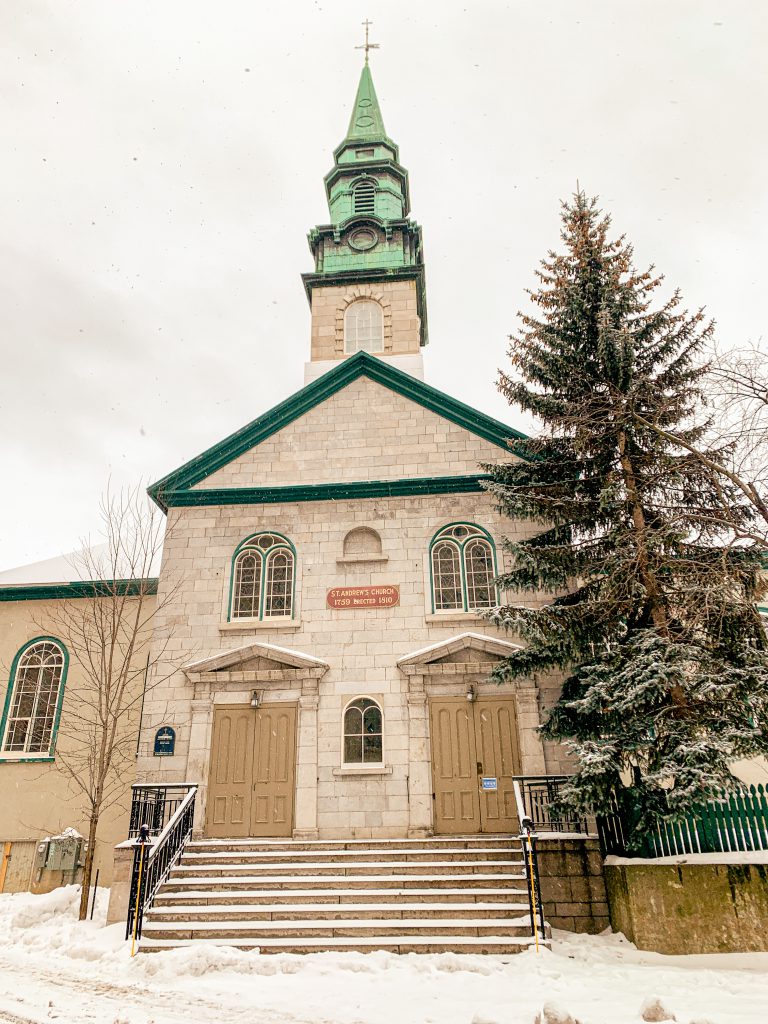
Language
Over 80% of residents in the Quebec province are native French speakers – because of this, you may be asking yourself “do I need to learn French, otherwise people are going to be rude to me?”
While, yes, you’ll hear French being spoken around you and see it on signs and in storefronts, you will also find that plenty of people speak English as well, especially in the main tourist areas.
I did try to cram in some French on Duolingo before my trip, but I found that I didn’t really need to use it at all – which is probably, but it was absolutely not needed – which was probably a good thing because my pronunciation is (still) atrocious! A few people did humor me though, and it was a fun place to practice.
Currency
Canada’s official currency is the Canadian dollar. The exchange rate works out to around $1.25 USD to $1 CAD (it ends up being like an automatic 25% discount if coming from the United States, yay!).
Virtually all places in Quebec City accept credit cards, so you probably won’t need much cash. The exceptions to this were the taxis and some of the vendors in the Christmas market. I took out a few Canadian dollars at an ATM in the Montreal airport for this purpose, although there are plenty of banks and ATMs throughout the city should you find yourself needing cash.
Like the US, tipping is mandatory in Canada. For meals, expect to tip 15-20%.
Departing Canada
Also note that if you are traveling back to the United States, pre-departure clearance is common in Canadian airports. This means that you will complete immigrations and customs clearance before departing Canada – allow yourself extra time for this!

Where to stay in Quebec City
Quebec City has many accommodation options to suit any taste and budget, whether you are looking for luxury stays, charming boutique hotels, inns, and anything and everything in between.
Here are some recommended places to stay during your weekend in Quebec City:
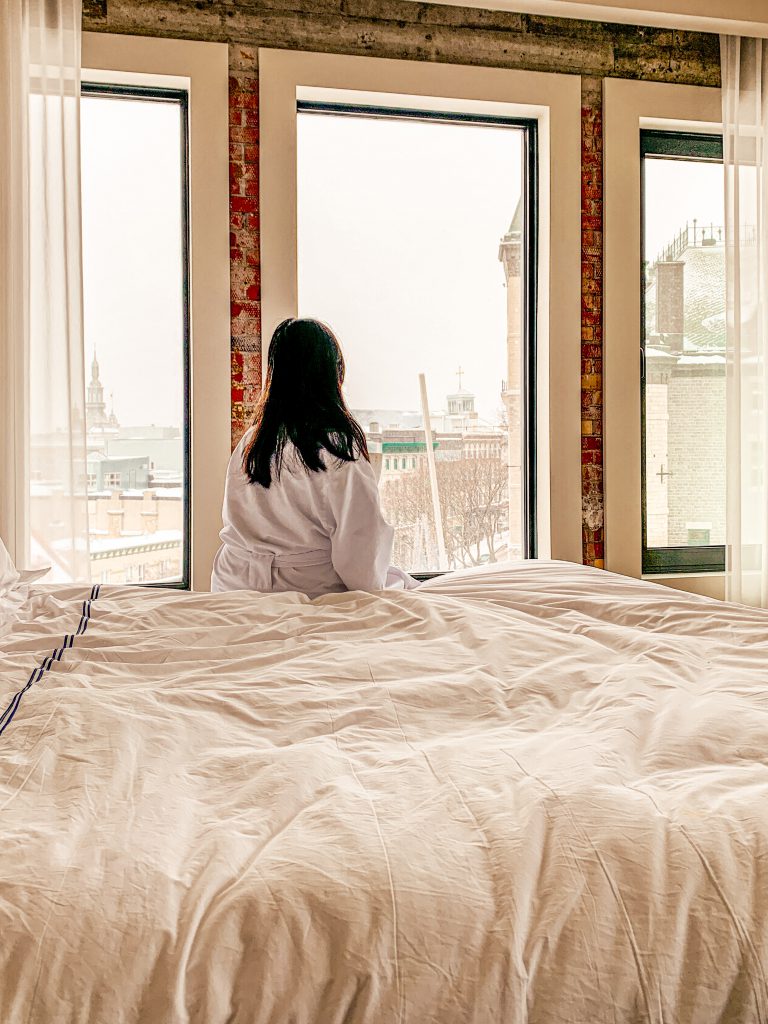

Monsieur Jean Hotel: Where I stayed, and I absolutely LOVED it! The boutique hotel is meant to invoke a dreamlike state, and has colorful art pieces, elegant furnishings, and a cozy atmosphere throughout the hotel, making it a unique place to stay.
The rooms are spacious and super comfortable, fully-equipped kitchenettes, stylish accents, and beautiful views of the city. My suite even had an amazing free-standing tub!
It’s also located in the heart of Old Quebec, conveniently located to many of the top things to do in Quebec City in 2 days.
Fairmont Chateau Frontenac: If you are looking for a luxurious AND unique stay in Quebec City, then you can’t do much better than the Chateau Frontenac. I mean…you’re not only going to be staying in an a literal castle, it’s also *the* most iconic building in the city!
You’ll be staying in the heart of Old Quebec, with stunning views of the city and St. Lawrence River. The hotel’s 610 rooms are beautifully furnished, with a sense of unparalleled elegance and luxury.
Yes, it can get pricey in the summer, but it is actually relatively affordable in the offseason – I saw rooms going for around $300 USD a night in December, which is super reasonable for a one-of-a-kind experience!
Le Monastere des Augustines: This is one of the most unique places to stay in Quebec City – it’s a former monastery that has been converted into a hotel, and you’ll find plenty of artwork, antiques, and relics throughout the property.
It’s a hotel that has a focus on health and wellness, with activities like yoga, tai chi and meditation that are offered.
The Perfect 2 Days in Quebec City Itinerary
Quebec City Itinerary Day 1: Explore Upper Town
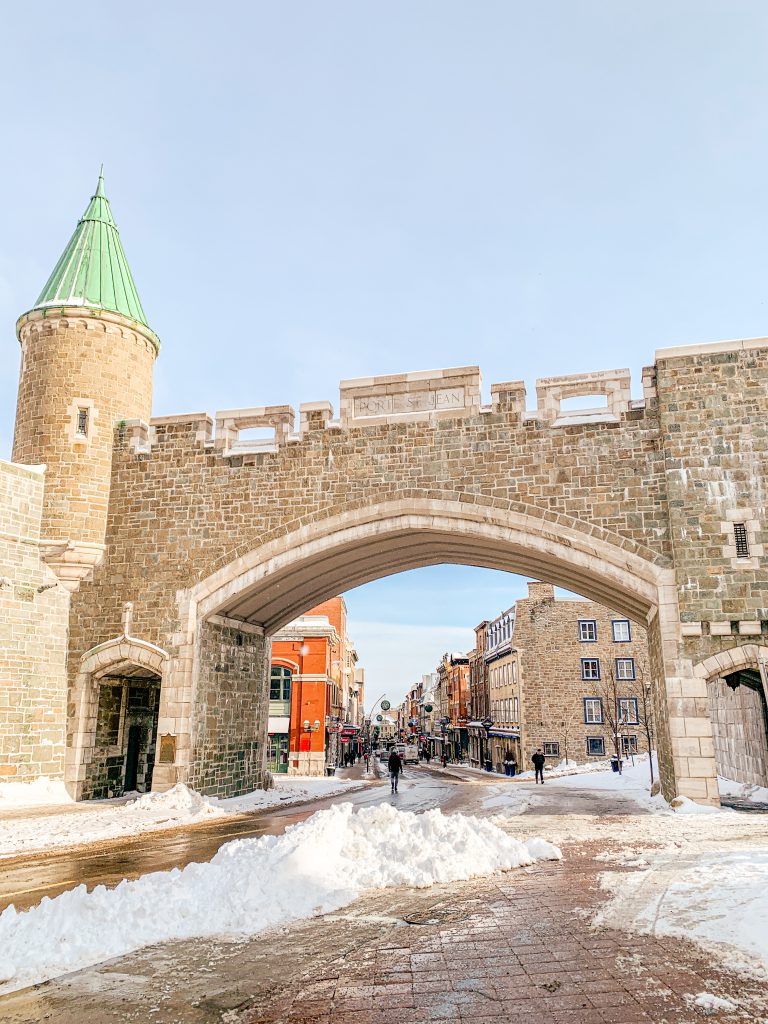
Fortifications of Quebec
DId you know that Quebec City is the only fortified city north of Mexico?
Stretching 4.6 kilometers, the Fortifications of Quebec bound the Upper Tower of the city, and offers a unique look into its military history.
Start at one of the gates on the fortification – I headed over to the Saint-Jean gate, which opens up to Rue Saint-Jean, and is also boarded by the Christmas Market and ice skating rink (it was magical to see it while skating!)
You can walk the entirety of the fortifications, which will allow you to see numerous gates, towers, canons, loopholes, and military sites. It also offers some beautiful views of the city and Old Town. Taking a walking tour will allow you to see all of the significant spots on the fortifications, while learning more about the city’s military history.
Do note that it gets icy during the winter – because of this, I decided to admire it from the gates.
If you choose to walk on the fortifications, take it until you reach the Citadelle.
Citadelle of Quebec + Plains of Abraham
Further along in Old Quebec is another fascinating monument from the city’s military history.
The Citadelle of Quebec holds over 300 years of the city’s military history, and is a key part of its fortifications.
Nicknamed the “Gibraltar of America,” the Citadelle of Quebec is the largest British fortress in North America, and has a unique star shape. Your admission ticket gives you access to a guided tour of the various historical buildings on site, including the oldest French military building in Canada, as well as its museum. The Citadelle is also home of the Governor General of Canada.
In the summer, you can also witness the changing of the guards ceremony, which takes place every day at 10am.
Nearby the Citadelle is the Plains of Abraham, another significant site in Quebec City’s military history. This is where the famous Battle of the Plains took place, when the British defeated the French in a pivotal battle of the Seven Years’ War. The French never regained control afterwards, marking it sort of like the unofficial birth of Canada.
Today, the site is a National Historical Park, and has many monuments, commemorative plaques, canons, interactive exhibits, and more. It is also known as one of the most prestigious urban parks in the world, and has a number of outdoor recreation opportunities year-round.

Parliament Building
One of Quebec City’s most iconic buildings, the Parliament Building is home to the National Assembly of Quebec, the central democratic institution of the province.
The Parliament Building is one of the oldest buildings in the city and has stunning architectural details. I suggest stopping to admire the facade, which also includes bronze sculptures of significant figures in Quebec City’s history – including Samuel de Champlain, Jaques Carter, among others.
Guided tours are also provided, through which you can learn more about Quebec’s parliamentary process and history.
Also be sure to admire the beautiful Tourny Fountain, which was a gift to the city from La Maison Simons, a local store, to commemorate the city’s 400th anniversary and won the gold medal at the 1855 World’s Fair in Paris.
The Parliament Building and Tourny Fountain are especially stunning in the spring, when the tulips and flowers bloom in front of it, but it really is a beautiful sight any time of year!

Lunch at Le Chic Shack
After exploring the Parliament Building, start walking towards the Chateau Frontenac, which will be your next stop after lunch. But first, time for a lunch break!
When in Canada, you absolutely must eat some poutine – it is essentially the national dish of Canada, and probably the most famous dish in French Canadian cuisine. If you’ve never had poutine, it consists of French fries with cheese curds, smothered in a rich gravy. Other toppings are added to it as well. It is absolutely rich, hearty, and delicious!
Le Chic Shack is technically a burger restaurant, serving up a wide variety of yummy gourmet burgers and shakes. However, it’s also known as one of the best places for poutine in Quebec City and it does not disappoint! Their version of poutine uses potato wedges, which soaks up the gravy sooo well. I had the mushroom poutine here and it was bomb!
Be sure to try one of their artisanal sodas, made in house, as well.

Chateau Frontenac
Visiting the Fairmont Chateau Frontenac was one of my highlights during my two days in Quebec City. Not only is it *the* most recognizable landmark in the city, it is also one of the most photographed hotels in the WORLD!
The Chateau Frontenac has stood in Quebec City for over 125 years, and has a rich and interesting history. It was built by William Van Horne, the former president of the Canadian Pacific Railway, who wanted to use the hotel as a way to promote luxury train travel.
Over the years, many famous people have stayed here, and it was even used as a filming site for an Alfred Hitchcock movie.

The inside of the hotel is as elegant as the outside, with a grand lobby area with Art Deco and wooden accents. There are over 400 artifacts on display here, which tell the story of the hotel and the city itself. During the holiday season, the hotel is dressed up with festive decorations as well!
Taking a guided tour will allow you to learn more about the hotel and hear stories about all the fascinating characters who shaped the hotel’s history. The tour also allows you to see some areas of the hotel that aren’t otherwise open to the public.
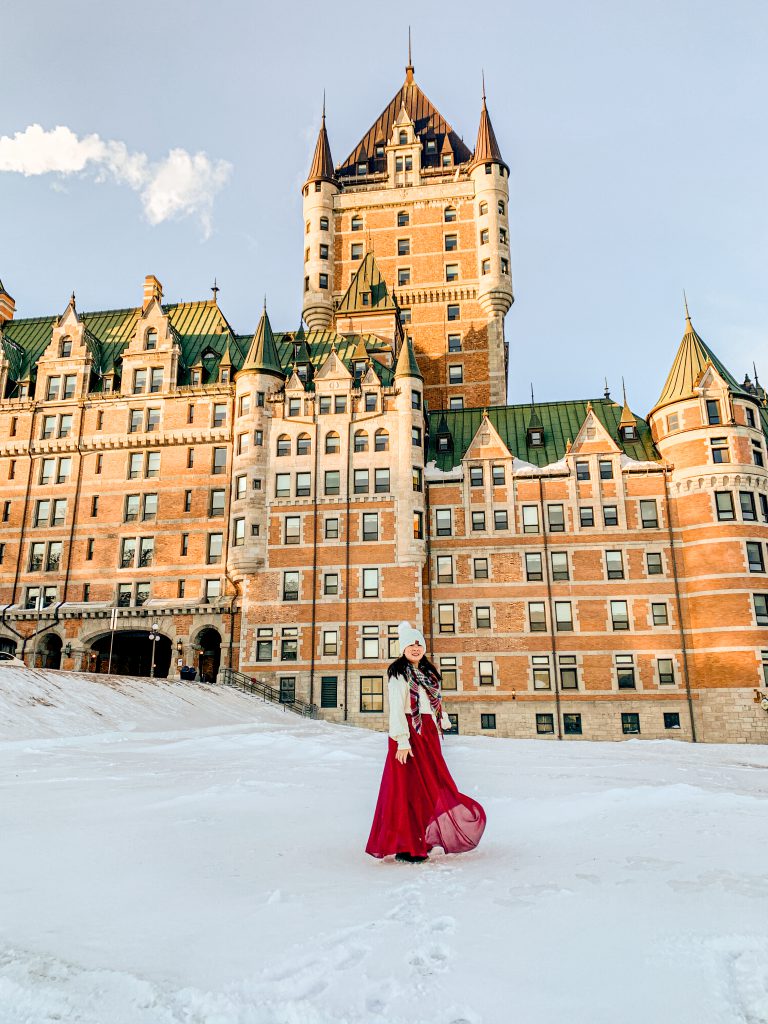
Dufferin Terrace
Sitting directly in front of the Chateau Frontenac, the Dufferin Terrace is a boardwalk that goes all the way to the Citadelle and Plains of Abraham. It also has one of the best views of the Chateau, and of the Lower Town and St. Lawrence River.
If you walk further along the boardwalk, you’ll eventually reach Pierre-Dugua-De Mons Terrace, which is also known to have one of the most beautiful views of the Chateau Frontenac.
As I spent my 2 days in Quebec City in winter, the terrace was covered in snow and with the Chateau in the background, it looked like a scene straight out of the movie Frozen and I had fun living out my Princess Elsa dreams here!


If you visit in the winter like I did, you absolutely must go down the toboggan slide here! The wooden slide has been here every winter for over 135 years, and can reach speeds of up to 40 miles an hour. It is SO much fun and was one of my highlights of my 2 day trip to Quebec City! Each ride costs $3.50 CAD (a bargain!), and you can purchase tickets inside Au 1884.
During the summer, it is a fantastic place to sit and relax and soak up the sun. You’ll find plenty of musicians and street performers lining the boardwalk, making it an excellent spot for some people watching. It’s also known as one of the best places to watch the fireworks!
In the summer months, you can also visit the Forts et Chateaux Saint Louis archaeological crypt, which holds the ruins of two forts and two chateaux that once stood here.

Hotel de Ville
The City Hall of Quebec City or Hotel de Ville is a beautiful building that is listed as a national historic site of Canada. It has an elegant exterior and is known as one of the most majestic city hall buildings in Canada.
It is surrounded by the Place de l’Hotel de Ville and a garden, which becomes lush and green during the spring and summer seasons. It is also the home of the impressive Jura Clock. Many locals and visitors come to relax and unwind during the warm weather months.


In the winter, the Hotel de Ville hosts part of the German Christmas Market and November and December. Here, you’ll find everything from traditional German foods, such as pretzels and gluhwein (mulled wine), to Canadian specialties, such as wool handicrafts and maple treats at the market. There are plenty of festive decorations to put you in the Christmas spirit as well!

Rue Saint Jean
One of the oldest streets in the city, Rue Saint Jean starts near Hotel de Ville, it extends all the way into the newer neighborhoods outside of the historic center. It is one of the liveliest streets in the city and home to one of its main shopping areas.
It’s the perfect street to do some window shopping, and there are plenty of unique boutiques, shops, galleries, cafes, bars, and restaurants to keep you busy for hours. You’ll find Francophile bookshops, gelaterias, chocolatiers, wine bars, specialty food stores, clothing boutiques, and much more.
Whatever you do (and no matter what time of year), be sure to stop into La Boutique de Noël de Quebec, where it’s Christmas all year round! Similar to Kris Kringle in Leavenworth, WA, you’ll find one-of-a-kind festive decorations and ornaments to help put you in the holiday spirit all year long – they make excellent souvenirs too! It’s one of Quebec City’s most unique shops, and it was even featured in a Korean drama!
Rue Saint Jean (and the side streets surrounding it, which have lots of gems as well) is an ideal place to have dinner, since there are so many awesome bars and restaurants along it. Which brings us to…
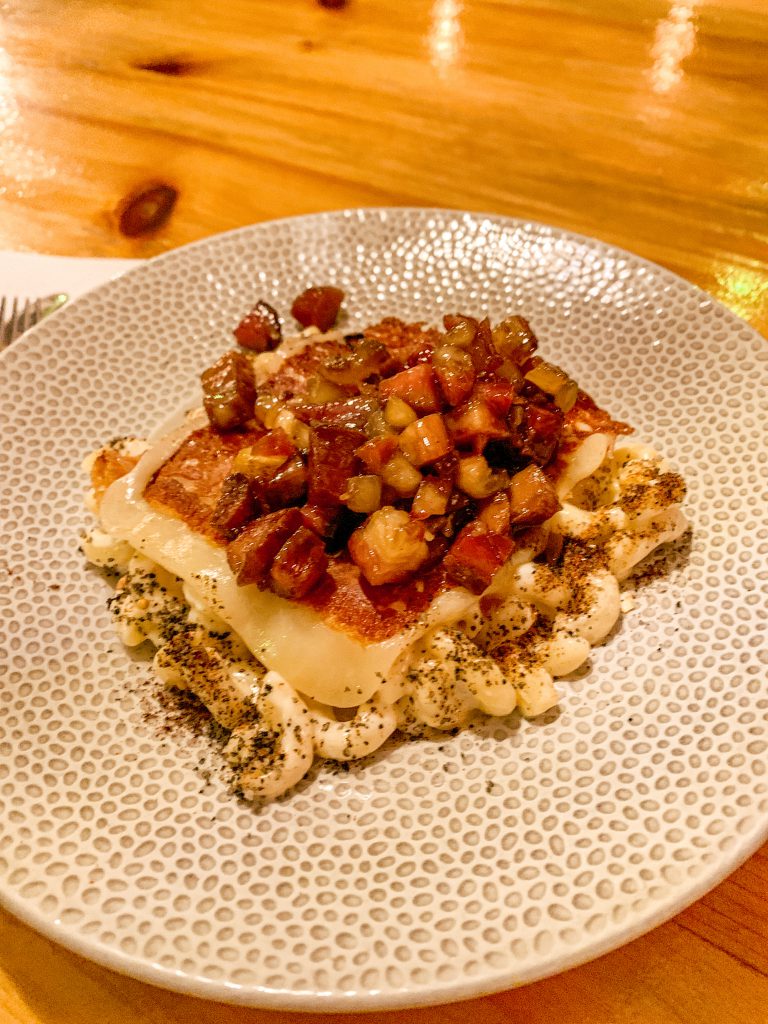

Dinner at Beclub Bistro
Beclub Bistro was a recommendation from the concierge from my hotel on my first night, and it really hit the spot. You’ll find plenty of Canadian bistro classics here.
It is tucked into a stone building on one of the side streets right off Rue Saint-Jean. Inside has a cozy, warm atmosphere, and you know you are going to find Canadian comfort food at its finest!
They are known for their smoked meats here, which they put on poutine or their version of a club sandwich. I had the mac and cheese here and it was divine – it had some amazing candied bacon on it! The smoked salmon appetizer was delicious as well – and plated so beautifully.
Quebec City Itinerary Day 2: Montmorency Falls + Lower Town

Montmorency Falls
Located just outside the city, Montmorency Falls is one of the most impressive natural sights in the area. Standing at 83 meters high (~272 feet), Montmorency Falls is actually a full 30 meters (almost 100 feet) higher than the famous Niagara Falls!
Sadly, I did not make it to Montmorency Falls because it was snowing quite a bit when I’d planned to go and I wasn’t feeling up to braving the snow and cold. However, it is one of the top attractions in the area, and several of my friends have gone and said it was pretty awesome, so I still recommend that you go during your weekend in Quebec City.
You can enjoy a view of the falls from right next to the parking lot, but there are many other adventures to be had in the park. There’s a cable car that goes up to the top of the cliff, which allows you to admire them from a unique perspective. There is also a suspension bridge that goes over the falls as well.
In the warmer months, you can take part in some thrilling adventures, such as going up the via ferrata routes that go up the cliff, or ziplining 300 meters (984 feet) above the falls.
If you are spending your 2 days in Quebec City in winter, visiting Montmorency Falls will give you a unique experience, as the falls will be frozen over!
Montmorency Falls is an easy 15 minute drive (or taxi ride) outside the city. If you don’t have a car, you can also take the 800 bus departing from Gare du Palais, the city’s main train station. There are plenty of guided tours as well, or you can take a shuttle bus. There’s even a bike tour for adventurous types!

Breakneck Steps
After your adventure in Montmorency Falls, you will be exploring the Lower Town of Old Quebec. Start your exploration of the Lower Town at the Breakneck Steps (Escalier Casse-Cou), which starts from Dufferin Terrace connects the Lower Town to the Upper Town.
It’s the oldest staircase in the city and dates back to the beginning of the French colony. The stairs were named by British tour guides in the 1960, although no serious injures have occurred there.
It’s got one of the best views of the Lower Town and Quartier Petit Champlain. In the warmer months, you’ll find patios set up right on the steps, and it’s an ideal place to hang out with a drink and enjoy the weather.
The 59 steps here are steep – I somehow found myself going up them even though I didn’t intend to and I was super out of breath – so I suggest that you take the stairs down, and then take the funicular up the hill later in the day.

Place Royal
Known as the birthplace of Quebec City, Place Royal is where Samuel de Champlain built the first French settlement in North America in 1608.
The square once used to serve as a marketplace and the buildings here were built out of wood. In 1682, a fire burnt down all the buildings and they were eventually built out of stone.
Today, it serves as a modern-day meeting place and is one of the most visited attractions in the city, with many tourists coming to snap photos of the charming stone facades with the colorful details.

One thing I noticed about Place Royal – it has a completely different vibe in the spring/summer and winter! When I came in winter, there were major festive vibes thanks to the beautiful Christmas tree that stood in the middle of the square.
However, in seeing tons of other photos of it during the warmer months, there ate flower boxes hanging from the facades of the buildings, along with tons of people hanging out on the outdoor patios, giving it a completely different look, which makes me really want to experience it in the spring/summer one day!
Lunch + coffee at La Maison Smith
Located in Place Royal, La Maison Smith is known as one of the best cafes in the city and is an ideal place to stop for lunch and/or take a coffee break. You’ll find a selection of delicious specialty coffee drinks, as well as a wide selection of pastries, sandwiches, salads, and soups.
In the summer, they have a patio set up where you can enjoy an iced coffee + lunch while people watching in the middle of Place Royal. In the winter, you can cozy up inside with a warm cup of coffee or hot chocolate.

Notre Dame des Victoires
Place Royal is home to one of the city’s most historically significant buildings in the Notre Dame des Victoires, the oldest stone church in North America. While small, the church is beautifully preserves and is one of the most beautiful buildings in the city.
The church is built on the site of the former home of Samuel de Champlain, and you can still see the outline of it. It was damaged during the Siege of Quebec, but was eventually rebuilt and today is a National Historic Site.
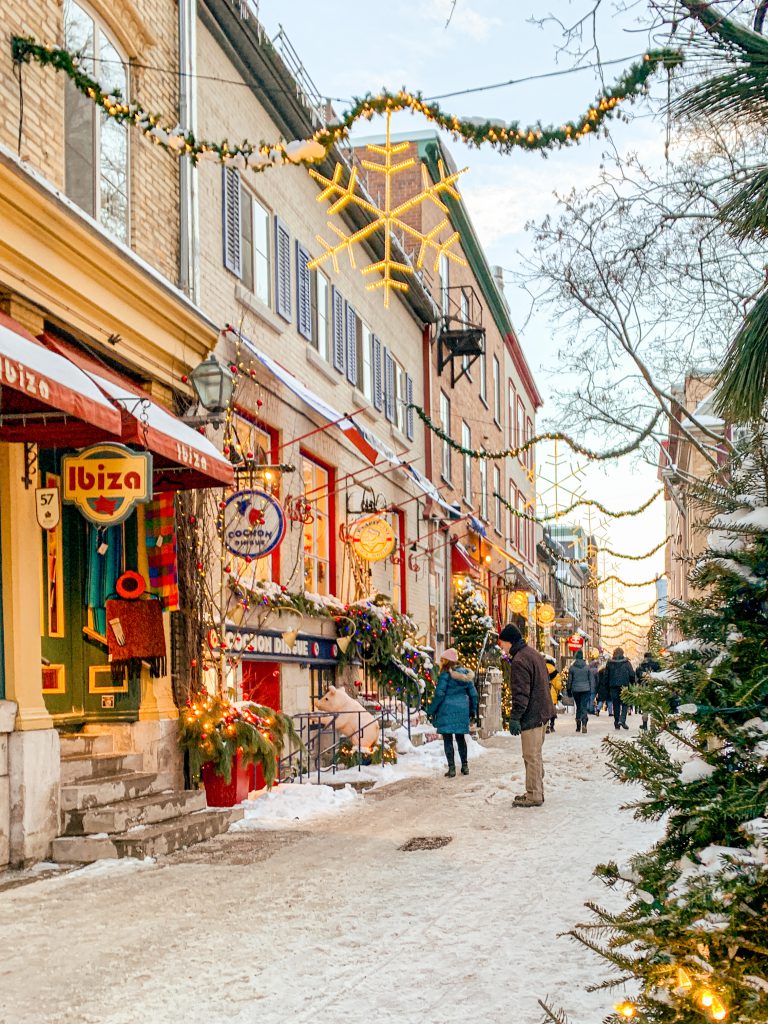
Quartier Petit Champlain
Visiting the Quartier Petit Champlain was an absolute highlight for me during my 2 days in Quebec City, and it was seeing photos of this postcard-perfect district that convinced me to visit in the first place!
Rue du Petit Champlain is the main street here, and it is one of the oldest shopping streets in North America. The stone facades that line the charming cobblestone streets house boutiques, souvenir shops, galleries, cafes, and restaurants.


Quartier Petit Champlain is extra magical in the winter months, when twinkling lights hang over the street. It looks straight out of a fairytale, especially when covered with a dusting of snow! It literally looks like a real-life Hallmark movie. And the best part? The lights stay up during the entirety of winter, through March!
I literally spent hours here wandering Rue du Petit Champlain and the side streets here, which are also charming on their own! I couldn’t help but snap literally hundreds of photos, because each scene looked dreamier than the last (seriously though it’s insane the number of photos and videos I have on my camera roll).
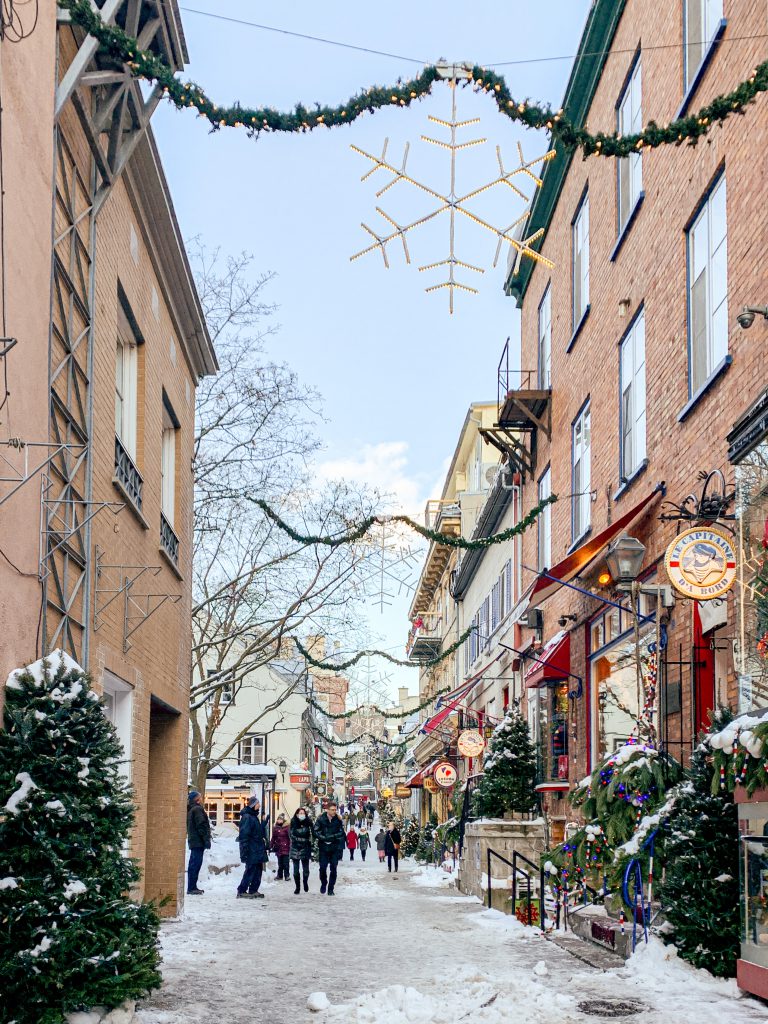

There are many unique small businesses here to keep you busy as well. It’s the perfect place to do some shopping or to relax with a drink, but be sure to also grab some maple treats at La Petite Cabane a Sucre de Quebec, which is a mini sugar shack and the next best thing when you can’t get to a real one.
Be sure to also walk down to Rue du Marche Champlain, which has one of the best views of the Chateau Frontenac, and Rue du Cul de Sac, which usually has colorful umbrellas hanging above it in the summer.

Fresque des Quebecois
Just next to the Quartier Petit Champlain is the giant Fresque des Quebecois mural. You absolutely cannot miss it (both literally and figuratively)!
This impressive mural is a visual illustration of Quebec City’s history, and commemorates some of its most significant historical figures. It’s like the story of the city brought to life, with its most famous people and places appearing on the mural.
It’s especially captivating because it’s so lifelike – at first glance, you think that you’re actually seeing a real place, but it is only upon closer inspection you realize that it’s an illustration!

Funiculare du Vieux Quebec
The historic Old Quebec Funicular (Funiculare du Vieux Quebec) has been in operation since 1879 and connects Quartier Petit Champlain in the Lower Town to Dufferin Terrace in the Upper Town.
I suggest that you take the funicular back up to the Upper Town, which will allow you to avoid the steep 59 step climb on the Breakneck Steps. Seriously, you’ll thank me later – those steps are a killer workout!
Besides, this is a much more fun way to get back up to Old Town! The funicular climbs up 210 feet at a 45 degree angle, and you’ll enjoy some gorgeous views of the St. Lawrence River, Lower Town, and Quartier Petit Champlain along the way.
The funicular operates from 9am to 9pm, seven days a week. A one-way ride costs $3.75.


Dinner at La Buche
You will end back up at Upper Town for dinner to close out this itinerary. Tonight, you will be eating at La Buche, which ended up being my favorite restaurant during my weekend days in Quebec City!
La Buche is a modern take on a sugar shack, serving up an extensive menu of Quebecois food. You’ll find an extensive selection of traditional specialties on the menu here, from toutiere (meat pie), poutine, and more.
I had the pate chinois here, which was like a Quebecois version of a shepherd’s pie and it was comforting and delicious! Be sure to also try the pouding au choumer (aka “poor man’s pudding”), which is sort of like a bread pudding in maple syrup and SO. FREAKING. GOOD!
Have you been to Quebec City? What would you include on your 2 days in Quebec City itinerary?
You might also like:
The Ultimate Guide to Quebec City in Winter
A Complete Guide to Christmas in Quebec City
The Perfect 2 Days in Montreal Itinerary
2 Perfect Days in Vancouver
Montreal Winter Travel Guide
Liked this post? Save this 2 days in Quebec City itinerary to Pinterest for later!
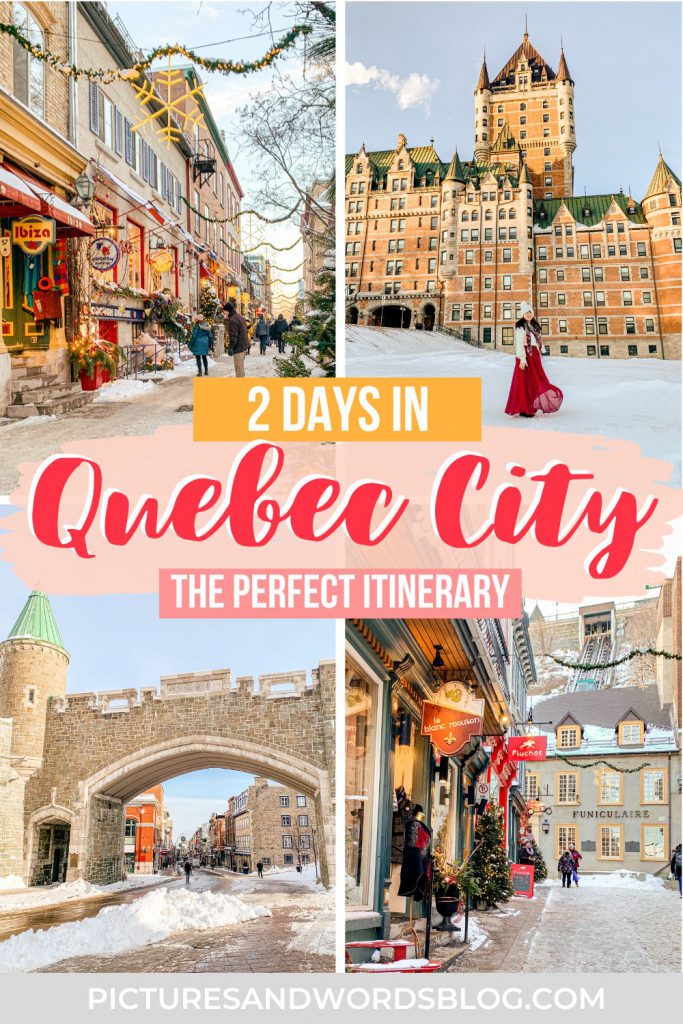

Caroline is a Southern California based traveler, writer, and photographer. She travels all around California, the US, and the world in search of the most colorful places, the most delicious food, and bucket-list adventures. Her aim is to inspire other travelers discover how to add more adventure and joy to their lives. On Pictures & Words, you’ll find detailed guides + itineraries, along with vibrant photos to help you plan the the most epic trips. When she’s not traveling, Caroline also runs half marathons.
